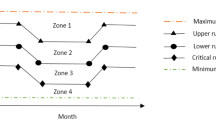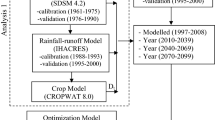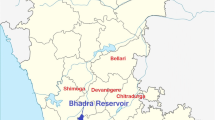Abstract
Water scarcity and flooding constitute major problems for developing countries located within the tropical climatic region of Southeast Asia. In addition, regional water consumption is increasing, and water usage patterns have been changing recently. Therefore, an advanced water resource management framework that considers both water supply and flood control is needed. Multipurpose reservoirs are widely used to manage water resources efficiently; however, water-related problems occur with reservoirs in Southeast Asian watersheds because of inadequate operation rule curves. We developed a method for constructing optimal operation rule curves for Dau Tieng Reservoir, which is one of the largest multipurpose reservoirs in Vietnam. The reservoir is used for flood control, domestic water supply, industrial uses, environmental flows, and agricultural uses, in the order of priority. The operation rule curves of the Dau Tieng Reservoir comprise five reference water levels: the retarding water level, upper water level, lower water level, critical water level, and dead water level. Water release from the reservoir is determined based on the relationship between the reservoir level and the rule curves. In this study, the rule curves were newly determined using the shuffled complex evolution method of the University of Arizona (SCE-UA method). The objective function for optimization was defined by focusing on the improvement in insufficient supply for agricultural uses and environmental flow downstream of the Dau Tieng Reservoir. Inadequate solutions were prevented by introducing penalty functions into the objective function. Experimental results indicate that the proposed optimization method efficiently searches for optimal rule curves.






Similar content being viewed by others
References
Abedian A, Ghiasi MH, Dehghan-Manshadi B (2005) Effect of a linear-exponential penalty function on the GA’s efficiency in optimization of a laminated composite panel. Int J Comput Intell 2(1):5–11
Adepelumi AA, Ako BD, Ajayi TR, Afolabi O, Omotoso EJ (2009) Delineation of saltwater intrusion into the freshwater aquifer of Lekki Peninsula, Lagos, Nigeria. Environ Geol 56(5):927–933
Asian Development Bank (ADB) (2016) Asian water development outlook 2016: strengthening water security in Asia and the Pacific. Asian Water Development Outlook
Chang FJ, Chen L, Chang LC (2005) Optimizing the reservoir operating rule curves by genetic algorithms. Hydrol Process 19:2277–2289
Chang LC, Chang FJ, Wang KW, Dai SY (2010) Constrained genetic algorithms for optimizing multi-use reservoir operation. J Hydrol 390:66–74
Chaves P, Chang FJ (2008) Intelligent reservoir operation system based on evolving artificial neural networks. Adv Water Resour 31:926–936
Chen L, Chang FJ (2007) Applying a real-coded multi-population genetic algorithm to multi-reservoir operation. Hydrol Process 21:688–698
Duan Q, Sorooshian S, Gupta VK (1992) Effective and efficient global optimization for conceptual rainfall-runoff models. Water Resour Res 28(4):1015–1031
Duan Q, Sorooshian S, Gupta VK (1994) Optimal use of the SCE-UA global optimization method for calibrating watershed models. J Hydrol 158:3–4
Holland JH (1975) Adaptation in natural and artificial systems. University of Michigan Press, Ann Arbor
Khan NM, Tingsanchali T (2009) Optimization and simulation of reservoir operation with sediment evacuation: a case study of the Tarbela Dam, Pakistan. Hydrol Process 23:730–747
Kummu M, Guillaume JHA, de Moel H, Eisner S, Flörke M, Porkka M, Siebert S, Veldkamp TIE, Ward PJ (2016) The world’s road to water scarcity: shortage and stress in the 20th century and pathways towards sustainability. Scientific Reports, Nature Publishing Group 6
Nelder JA (1965) A simplex method for function minimization. Comput J 7:308–313
Ngo LL, Madsen H, Rosbjerg D (2007) Simulation and optimisation modelling approach for operation of the Hoa Binh reservoir, Vietnam. J Hydrol 336:269–281
Ngoc TA, Hiramatsu K, Harada M (2014) Optimizing the rule curves of multi-use reservoir operation using a genetic algorithm with a penalty strategy. Paddy Water Environ 12(1):125–137
Sorooshian S, Duan Q, Gupta VK (1993) Calibration of rainfall-runoff models: application of global optimization to the Sacramento soil moisture accounting model. Water Resour Res 29(4):1185–1194
Suen JP, Eheart JW (2006) Reservoir management to balance ecosystem and human needs: incorporating the paradigm of the ecological flow regime. Water Resour Res 42:W03417
Takada A, Hiramatsu K, Ngoc TA, Harada M, Tabata T (2018) Development of a mesh-based distributed runoff model incorporated with tank models of several land utilizations in a Southeast Asian watershed. In: Proceedings of the 21st congress of International Association for Hydro-Environment Engineering and Research (IAHR) Asia Pacific Division (APD), vol 1, pp 539–547
Tanakamaru H (1995) Parameter estimation for the tank model using global optimization. Trans Jpn Soc Irrig Drain Reclam Eng 178:103–112 (in Japanese)
Wang QJ (1991) The genetic algorithm and its application to calibrating conceptual rainfall-runoff models. Water Resour Res 27(9):2467–2471
World Meteorological Organization (WMO) and Global Water Partnership (GWP) (2008) Urban flood risk management—a tool for integrated flood management. Associated programme on flood management
Acknowledgements
The authors greatly appreciate funding support under JSPS KAKENHI (Grant Number: 18H03968).
Author information
Authors and Affiliations
Corresponding author
Rights and permissions
About this article
Cite this article
Takada, A., Hiramatsu, K., Trieu, N.A. et al. Development of an optimizing method for the operation rule curves of a multipurpose reservoir in a Southeast Asian watershed. Paddy Water Environ 17, 195–202 (2019). https://doi.org/10.1007/s10333-019-00711-8
Received:
Revised:
Accepted:
Published:
Issue Date:
DOI: https://doi.org/10.1007/s10333-019-00711-8




